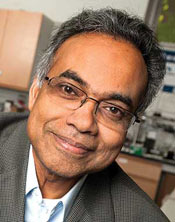Date
Cost
Free and open to the public
Location
Research Pavilion, Room 475 (NanoScience Technology Center)
Description
A micro and nanofabricated mechanical sensor platform satisfies almost all the requirements of an ideal sensor for physical, chemical, and biological detection. These include miniature size, low power consumption, high sensitivity, array-based multi-analyte detection, and decreased cost as a result of their ability for mass production. In spite of all the demonstrated advantages, a multitude of challenges still exist in making this sensor platform a working reality. One of the greatest disadvantages these sensors have is their lack of any intrinsic chemical selectivity. Attempts to achieve very high selectivity through interfacial modification fail to achieve selectivity in complex environments. The reliable modification of this type of sensor in order to achieve chemical selectivity in an array format has also been a challenge. The lack of simple, multiplexed readout techniques is another challenge. Yet another issue is how to provide reliable electrical power without significantly increasing the size and reducing the operational life of the sensor. However, surprising solutions exist which could address these challenges. Combining optical sensing concepts with the nanomechanical sensors has the potential to enhance chemical selectivity without compromising sensitivity. Combining nanomechanics with electrochemistry can also address some selectivity issues. Recently, we have developed a single wire electricity transmission concept. This approach has the potential to revolutionize the field of miniature sensors by developing sensors without imbedded batteries. I will discuss hyphenated-nanomechanical sensor paradigms which could be used to solve current sensor challenges as well as the single wire electricity transmission concept. I will also address the role of nanomechanical sensors in standoff detection and imaging.
Biography:
Prof. Thundat currently holds a Canada Excellence Research Chair in Oil Sands Molecular Engineering. Prior to becoming the CERC Chair in Oil Sands Molecular Engineering, Dr. Thundat was a University of Tennessee-Batelle/Oak Ridge National Laboratory (ORNL) Corporate Fellow and led the Nanoscale Science and Devices Group at ORNL. He holds professorships at the University of Tennessee in Knoxville, the University of Burgundy in France and an honorary professorship at the Indian Institute of Technology in Madras. He received his Ph.D. in Physics in 1987 from the State University of New York – Albany. Dr. Thundat has authored over 285 publications in refereed journals, 48 book chapters and 30 patents. He has received a number of awards, most recently the Outstanding Achievement Award in the Sensor Division of the Electrochemical Society. As well, Dr. Thundat has received the American Society of Mechanical Engineers Pioneer Award, the Batelle Distinguished Inventor Award and many ORNL awards for research and development. He is an elected Fellow of the American Physical Society, the Electrochemical Society, the American Association for Advancement of Science, and the American Society of Mechanical Engineers.
Presenter

Thomas Thundat, Ph.D.
Department of Chemical and Materials Engineering University of Alberta
Contact
Rebeca Barrios NanoScience Technology Center 407-882-1515 NSTCsearch@ucf.edu